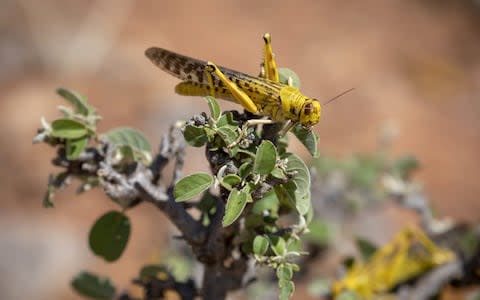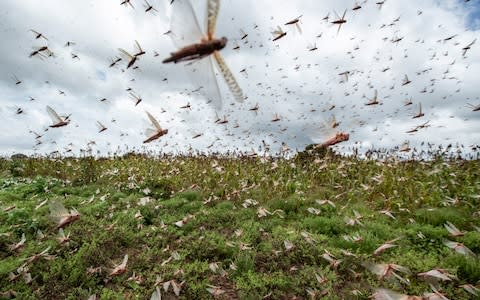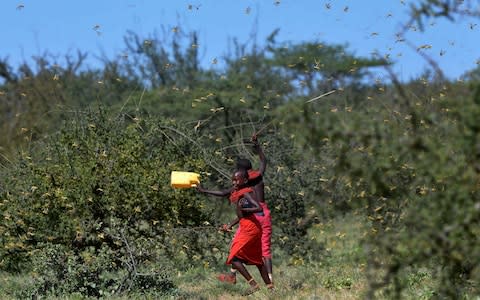Africa threatened with severe food crisis as locust 'mega-swarms' devour crops

The locusts are coming thick and fast as the low-flying aircraft punches through the swarm, leaving khaki-coloured streaks smeared across the plane’s windscreen and obstructing the view outside.
But the pilot - despite travelling at 100 miles per hour - is unfazed. He simply winds down the window of the unpressurised cockpit, reaches his arm outside and wipes away what’s left of the insects with a damp cloth.
This is life on the frontline for locust hunters, as they battle to contain the worst plague to hit the Horn of Africa for some seven decades - on Monday, the United Nations will convene a conference in Rome with the aim of mobilising $70 million (£53 million) to help respond to the crisis.
The swarms emerged in Yemen early last summer but have since poured into northern Kenya - where a “super-swarm” some 2,400 square kilometres wide was spotted last week.
It is only the third time since 1950 that locusts swarms have been seen on this scale.

In the last serious locust upsurge, between 2003 and 2005 across some 20 countries in North Africa and the Middle East, roughly $750 million (£574 million) was spent to bring the swarms under control, and some 12 million hectares of land were sprayed with pesticides.
In biblical style, the locusts have already devoured and destroyed 70,000 hectares (175,000 acres) of farmland across Somalia and Ethiopia, and earlier this month a passenger plane was diverted and grounded in Ethiopia after an unexpected swarm blocked its entry to Dire Dawa airport.

Concerns have already been raised that the invasion could threaten a food crisis and stall economic growth in the region unless the situation is brought under control.
“The current situation is easily the worst we’ve had in decades and is a result of very unusual cyclones,” said Keith Cressman, the Food and Agriculture Organisation’s (FAO) lead locust expert.
“Cyclones bring very heavy rains, meaning breeding conditions for desert locusts are extremely favourable for much longer than usual. As a result swarms can grow very rapidly… the numbers just skyrocket.”

He added that these cyclones have in turn been triggered by climate change, which has made extreme weather events all the more common worldwide.
But containing the plague is easier said than done, said Mehari Tesfayohannes, chief information and forecasting officer at the Desert Locust Control Organisation (DLCO) for Eastern Africa – the team trying to control the ravenous insects from the sky.

In specially modified Turbo Beaver aircrafts equipped with spray equipment and pesticide tanks locust hunters fly hundreds of miles across nine countries in east Africa to track down and target the swarms.
“Of course sometimes the windshields are smeared with crushed and dead locusts, blocking the pilot from seeing outside,” Mr Tesfayohannes, who has worked for DLCO Eastern Africa since 1992, told The Telegraph. “But as the pilots are aware of this, they usually carry moist cloth to wipe it.”

The lightweight Beaver planes are specially modified to protect against denting due to locust crushing, while the engine cooling systems are fixed with strong wire meshes to avoid blocking by the crushed locusts,” said Mr Tesfayohannes.
But with just four planes at their disposal, ending the plague is a big task for a small team – especially this year.
The UN has warned that the swarms represent an “unprecedented threat to food security” with locust numbers potentially increasing 500-fold in the next six months.

“Locusts eat practically everything,” said Mr Cressman of the FAO, “A swarm can come into a farmer’s field in the morning and by midday there won’t be anything left. That field could easily have represented a family’s food for a year.”
Mr Tesfayohannes is not optimistic that enough resources have been allocated to the current crisis. “To tell the truth, at the moment even though we have some trainee pilots, we are facing a shortage of pilots who can fly the Beavers,” he said.
Protect yourself and your family by learning more about Global Health Security. And sign up to our weekly newsletter here.


